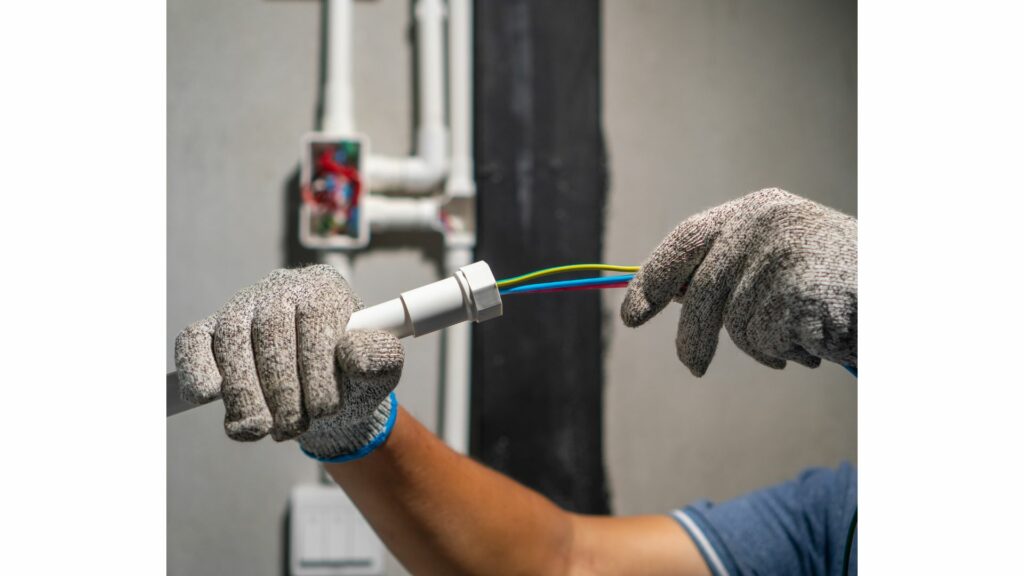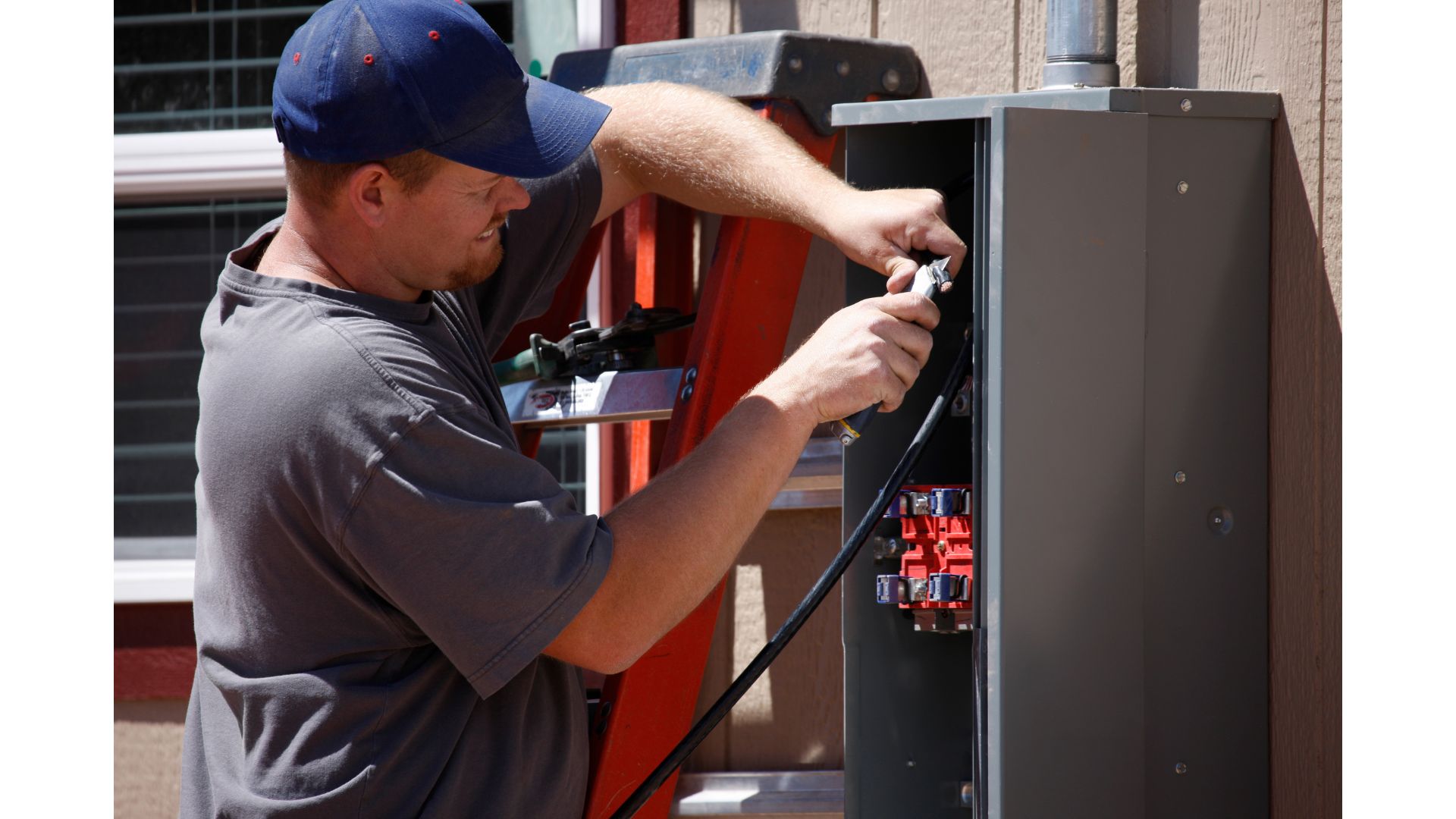Most laypeople have never seen service entrance cables because they rarely interact with these conductors during their daily lives.
1). What Is A Service Entrance Cable?
Nassau National Cable describes a service entrance cable as an electrical line that connects your home to the grid. It brings electricity to your property. In other words, the cables serve a vital purpose. This Department of Labor and Industry guide has identified two types of service entrance cables:
- SE – This type has a jacket that resists fire and moisture.
- USE – This type is also moisture resistant. But it doesn’t offer flame-retardent sheathing.
Type SE works above ground. You can’t install it underground. But it does a decent job of tolerating wet locations. Any retailer you consult will ask you to specify the type of SE service entrance cable you want. Your options include RHW, THWN, XHHW, XHHW-2, and THWN-2.
Type USE stands out because it is suitable for underground installations. You can bury it directly. Some USE cables are single-conductor types. You also have multi-conductor options on the market.
People don’t use USE cable inside, excluding terminations at the service equipment. On the other hand, type SE cable can work inside. Consumers apply it to heating and cooling devices, branch circuits, and subpanels.
Laypeople routinely confuse SER and USE cabling. They think SER works underground. They also make the same assumption about SEU cables, but that is untrue. SER is round, boasting four conductors and a bare neutral. It works above ground.
SEU is unarmored and oval. Expect two-phase conductors and a concentric neutral but no ground conductor. If you want to perform an underground installation, deploy USE.
2). Why Conduits?

To understand the relationship between conduits and service entrance cables, you need to know the function conduits play and why people use them. Conduits are pipes that encase wires. People use them for the following reasons:
- The NEC has clauses that demand the use of conduits. This is also true for your local building code. You pull the wires through tubes to avoid the hefty penalties people attract when they ignore the local code.
- Some people use metal conduits to provide grounding. The pipe works in the place of a conventional grounding wire. This practice was common in the past. Today, contractors prefer to include a grounding wire even when the tube is metal.
- You should run exposed wires through a conduit to defend them from dangerous elements. The goal is to enhance the line’s durability. The tubing provides an additional layer of protection. An exposed wire is vulnerable to numerous factors, including human traffic, moisture, pests, snow, etc. Frail wiring will break unless you defend it.
- People bury wires to protect them from the elements. However, underground installations are just as dangerous because they expose the wires to moisture, pests, and pressure. In fact, burying a cable may do more harm than good.
You have exceptions. For instance, armored cables can survive in rugged settings without a conduit. Additionally, you can bury certain cable types without pipes because the manufacturer rated them for direct burial.
This shouldn’t stop you from pulling armored or underground lines through a conduit if the need arises. Most local codes expect consumers to apply common sense in this area. Local authorities will compel contractors to use pipes. But they rarely prohibit this practice.
You can even deploy conduits indoors. They are not strictly an outdoor tool, as many people presume. The key is to select the correct tube. You don’t want to force a large cable through a tiny pipe. First of all, the wire may get stuck, forcing you to throw both items away. Secondly, even if you succeed, you risk damaging the wire.
3). Service Entrance Cables VS Conduits
You can pull service entrance cables through a conduit, especially if you want to protect exposed wires above ground from harm. You can use PVC cables in tubes because PVC is highly toxic. The USE type can run underground without a pipe because the line is rated for underground use. But you can install a conduit where necessary.
Most contractors would rather avoid pipes where cables rated for direct burial are concerned. But sometimes, the destructive elements in the vicinity won’t give you any other option.
What Does The NEC Say About It?
Up Codes has highlighted section 338.12, which prohibits the use of SE lines in settings that expose the wires to physical damage. They also prohibit the use of SE cables underground regardless of whether you have a raceway or not. If you want to run service entrance cables through locations that expose the lines to physical damage, section 230.50(B) mandates the use of conduits.
These sections give contractors the green light to use conduits wherever they see fit. It is worth noting that the NEC has prohibited the use of USE cables for interior wiring, above-ground, and aerial cabling.
Don’t proceed without confirming the local code’s stance on the issue. The local code takes precedence. If it warns against using service entrance cables in a conduit, you should listen, regardless of the NEC’s opinion on the matter.
Find a contractor you can trust to make these decisions. Contractors usually remain abreast of changes in the local code. They won’t lead you astray.
What Kind of Conduit Should I Use For Service Entrance Cable?

You have several conduit types to choose from, including:
Rigid Metal – RMC is strong, durable, and expensive. Service providers want you to pair this conduit type with service entrance cabling because it can withstand everything from severe storms to falling objects.
Galvanized Steel – This type offers impact resistance, UV stability, and EMI protection. But it is expensive, difficult to handle, and susceptible to corrosion.
Intermediate Metal – you can use IMC in place of RMC. The conduit is lighter and cost-effective. However, it has thinner walls.
Electrical Metallic Tubing – EMT works in commercial, industrial, and residential settings. The conduit is easier to bend, but it cannot match the protection you get from galvanized steel conduits.
Flexible Metal – You can pull this conduit around tight bends. It can withstand vibrations.
PVC – You can run this conduit underground. It can tolerate applications in wet locations.
Up Codes has listed several conduits for service entrance cables recommended by the NEC, including:
- Rigid Metal
- Electrical Metal Tubing
- Reinforced Thermosetting Resin Conduit
- Intermediate Metal Conduit
- PVC (Schedule 80)
Naturally, this list doesn’t tell you anything because it doesn’t consider your situation. The NEC has listed the conduits you may require without revealing the type you should pick. Your selection will depend on the setting and application.
Conduit Size For Service Entrance Cable
It depends on the size of the cable. For instance, you can use 2-2-2-4 SER line to use a 2-inch conduit. The ampacity will determine the cable size. Without the cable size, you cannot select a suitable conduit size.
Where conduits are concerned, service entrance lines tend to follow the same rules as all other electrical wire types.
Read
- What Size Conduit For 8, 8/2, 8/3, 8/4 AWG Wire?
- How Many 2, 4, 6, 8, 10, 12, 14 Gauge Wires In 1/2 Conduit?
- 4, 6, 8, 10, 12, 12/2, 14, 14/2 AWG Wire Vs. 3/4 conduit
The Best Way To Run Service Entrance Cable
Running cables through a conduit is not complicated. But it requires a lot of time and effort. The goal is to safely force a wire through a pipe. Smaller lines require less effort than their thicker counterparts. You can deploy any method that suits you so long as the cable passes through the conduit without accruing damage.
The last thing you want is to scrape the insulation off. The string method is the most popular technique because of its simplicity. You execute the strategy by tying a string to a long, stiff rod. Pushing the rod through the conduit accomplishes the most challenging aspect of this procedure.
It gets one end of the string through the conduit. Once the string emerges from the pipe, you can remove the rod before tying the other end of the string to the cable you want to pull through the conduit. The rest is obvious. Keep pulling until the line successfully traverses the pipe.
The conduit mouse and fish tape methods follow a similar principle. But you use a conduit mouse and fish tape instead of a string. Use any procedure that allows you to pull the service entrance cable through the tube without damaging it.

